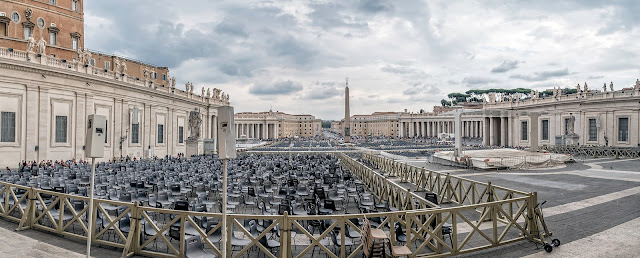The Papal Basilica of St. Peter in the Vatican, or simply St. Peter's Basilica (Italian: Basilica Papale di San Pietro in Vaticano), is a Late Renaissance church located within Vatican City.
Designed principally by Donato Bramante, Michelangelo, Carlo Maderno and Gian Lorenzo Bernini, St. Peter's is the most renowned work of Renaissance architecture and remains one of the two largest churches in the world. While it is neither the mother church of the Catholic Church nor the Catholic Roman Rite cathedral of the Diocese of Rome, St. Peter's is regarded as one of the holiest Catholic shrines. It has been described as "holding a unique position in the Christian world" and as "the greatest of all churches of Christendom".
By Catholic Tradition, the Basilica is the burial site of its namesake St. Peter, one of the Apostles of Jesus Christ and, also according to tradition, the first Pope and Bishop of Rome. Tradition and strong historical evidence hold that St. Peter's tomb is directly below the high altar of the Basilica. For this reason, many Popes have been interred at St. Peter's since the Early Christian period. There has been a church on this site since the time of the Roman Emperor Constantine the Great. Construction of the present basilica, replacing the Old St. Peter's Basilica of the 4th century AD, began on 18 April 1506 and was completed on 18 November 1626.
St. Peter's is famous as a place of pilgrimage, for its liturgical functions. Because of its location in the Vatican, the Pope presides at a number of liturgies throughout the year, drawing audiences of 15,000 to over 80,000 people, either within the Basilica or its adjoining St. Peter's Square. St. Peter's has many strong historical associations, with the Early Christian Church, the Papacy, the Protestant Reformation and Catholic Counter-reformation, and with numerous artists, most significantly Michelangelo. As a work of architecture, it is regarded as the greatest building of its age. St. Peter's is one of the four churches of Rome that hold the rank of Major Basilica. Contrary to popular misconception, it is not a cathedral because it is not the seat of a bishop; the Cathedra of the Pope as Bishop of Rome is located in the Archbasilica of St. John Lateran.
The following photo show the view from behind the Pope's stand of St. Peter's Square as I was standing on the steps of St. Peter's. It is here where the Pope addresses the Papal Audience. His stand is visible on the right side of this picture.
Swiss Guards are the Swiss soldiers who have served as guards at foreign European courts since the late 15th century. Currently, the name Swiss Guard generally refers to the Pontifical Swiss Guard of the Holy See stationed at the Vatican in Rome. The Papal Swiss Guard has a bodyguard-like role. Recruits to the guards must be Catholic, single males with Swiss citizenship who have completed basic training with the Swiss military and can obtain certificates of good conduct. Recruits must have a professional degree or high school diploma and must be between 19 and 30 years of age and at least 174 cm (5 ft 8.5 in) tall. The official dress uniform is of blue, red, orange and yellow with a distinctly Renaissance appearance.





















